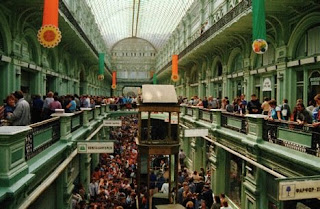When you flush away your cares/TP/Goldie the Goldfish.. how much water are you using?
There are standards, but each toilet will perform differently. Check the labels printed on the little rectangle of porcelain behind the seat - but be aware that these are not always an accurate representation.
1 gallon per flush = urinal
1.2 gallons per flush = high efficiency
1.6 gallons per flush = low flow (mandated in California post-1992)
3.6 gallons per flush = high flow
anything higher = yikes
Even if you know what your toilet is SUPPOSED to flush, it's hard to tell exactly how much water it's using without measuring. Some conservation specialists are so attuned that they can tell the toilet's capacity by the sound of the flush. Us laymen need a little more assistance. The good news - especially for those of us teaching junior high schoolers about volume - is that there is an equation you can use!

(picture: "
Fish n' Flush," which, for the record, is 2.2gpf)
You will need a measuring tape.
1. Take the top off your toilet. I know, I know, this isn't the most fun in the world. Don't balk at this step. I promise, it will be worth it.
2. Measure the length of the toilet. Measure so the metal tab at the end of the tape fits against the inside edge of the tank. Record this number (usually about 15.75").
3. Measure the width of the toilet. Again, make sure you are only measuring the inside of the tank. Record this number (usually about 5.25").
4. Now send the metal end of the measuring tape down to the bottom of the tank to record the inches of water when the tank is full. Remember this number (about 8") and leave the tape there, as you prepare for the most exciting step which is.....
5. Flush the toilet!! Watch your tape carefully and record the inches of water when the tank is at its lowest (about 4").
6. Subtract the full inches - empty inches. This number is called the "drop." This is the number of inches of water that leave the tank and go into the bowl every time you flush. (about 4")
7. Now take your drop (about 4") and multiply it by the length and width. This gets you cubic inches of water for each drop (volume!). (usually 400-500 cubic inches)
8. Your magical constant is 231. Divide your cubic inches by 231. Add .5.
9. Suddenly you have converted to gallons per flush! This number should be between 1 and 7.
1.6 gpf = low flow
3.6 gpf = high flow
anything higher = yikes
So again, the equation is ((length) * (width) * (full-empty))/231 +.5
If you see no water in your tank, only a black box, that means that you have an HET (high efficiency toilet). Good for you! Make sure there's no water in the tank, or else you've got a leak.
So now what? If you have a 3.6 gpf toilet or higher, contact your local water retailer. They probably will offer you some kind of rebate. Some will even direct-install an HET (all you do is say you want it and let them in. They show up and do everything free).
Who offers one?
Dallas does!
Petaluma does!
Southern California does! Who do you pay for water? Call them up and demand an HET rebate!
And, for good measure, a creepy anthropomorphic water droplet from
ecojoes.com.

Actually, this one does not look so much creepy as stoned.
 image from dralanbittner.com.
image from dralanbittner.com.













































